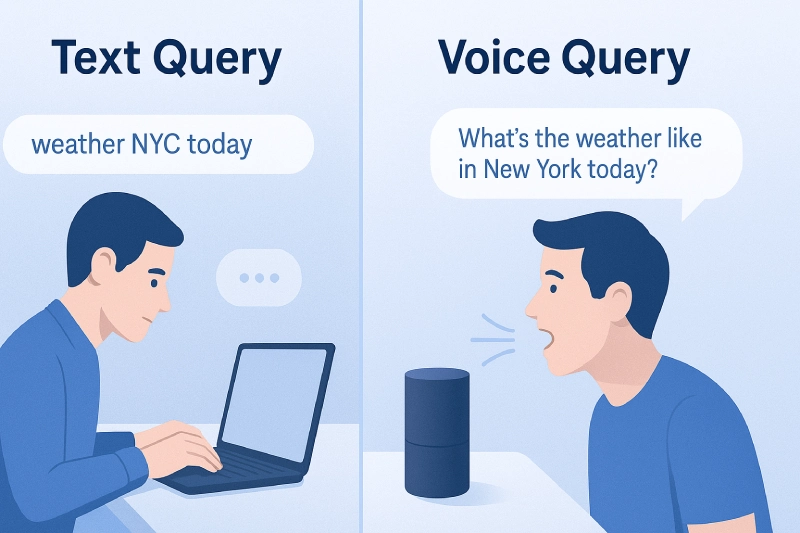Voice search optimization is no longer just a trend—it’s quickly becoming a necessity for anyone serious about SEO in 2025 and beyond. As more people rely on smart assistants like Alexa, Siri, and Google Assistant to search the web hands-free, the way we create and structure content needs to evolve.
Think about it: instead of typing “best budget smartphones 2025,” users now say things like, “Hey Google, what’s the best budget phone I can buy this year?” That subtle shift—from keywords to full questions—completely changes how search engines interpret content and rank results. And with nearly half of all online searches now voice-activated (according to recent Comscore data), ignoring this behavior means leaving traffic (and conversions) on the table.
In this guide, we’ll break down what voice search optimization really means, why it’s reshaping modern SEO, and how you can future-proof your content strategy to meet the changing demands of search.
What is Voice Search Optimization?
Voice search optimization is the process of tailoring your website content to improve visibility and ranking for queries spoken aloud to smart devices. Unlike traditional SEO, which focuses on typed keywords, voice search leans into natural, conversational language—the way people actually talk.
Here’s how it differs:
When someone types, they might write, “weather NYC today.” But when speaking, they say, “What’s the weather like in New York City today?” That longer, more human-sounding query needs content structured in a similar tone to match search intent.
Optimizing for voice means:
- Using long-tail keywords and question-based phrases
- Writing in a conversational tone
- Answering common questions clearly and directly (hello, FAQs!)
- Ensuring your site is mobile-friendly and loads fast—since most voice searches happen on mobile
Post-2025, voice search isn’t just convenient—it’s mainstream. With smart speakers in nearly every home and voice assistants built into phones, cars, and even TVs, businesses that adapt now are setting themselves up to dominate tomorrow’s search results.
Sure! Here’s the next part of your blog post, including the sections “Why Voice Search is the Future” and “How Voice Search Affects SEO and Content Strategy”, with natural use of the keyword voice search optimization and all requested elements.
Why Voice Search is the Future of Search
The way people search online is rapidly evolving, and voice search is leading the charge. As of 2025, over 60% of smartphone users use voice commands at least once a day. From asking Alexa about the weather to using Siri for driving directions, speaking is often faster, easier, and more convenient than typing.
🔹 Smart Speakers, Smartphones & Virtual Assistants
Voice-enabled devices are now everywhere:
- Smartphones (iPhone with Siri, Android with Google Assistant)
- Smart speakers (Amazon Echo, Google Nest)
- Wearables and in-car systems (Apple Watch, Android Auto)
According to Statista, over 400 million smart speakers are in use globally—a number expected to grow as voice AI improves. This shift means brands must think beyond keyboards.
🔹 Voice vs. Text: Changing User Behavior
Voice queries are:
- Longer and more conversational
- Often question-based
- More likely to include intent-heavy phrases
For example:
- Typed: “cafe near me”
- Spoken: “Where is the best cafe near me that’s open now?”
These natural-sounding questions reshape how we create content. People are searching like they talk, and voice search optimization helps ensure your website speaks their language.
How Voice Search Affects SEO and Content Strategy

Voice search doesn’t just change how people ask questions—it changes how Google delivers results. It puts featured snippets, local listings, and FAQ-rich pages at the forefront of search visibility.
💥 Here’s how voice search is reshaping SEO:
- Featured Snippets Win More Traffic
Google often pulls answers from snippet-ready content to respond to voice queries. That means concise, well-structured content performs better. - Local SEO Gets Even Bigger
Voice search is used frequently on-the-go, especially for local intent:- “Where’s the nearest petrol pump?”
- “Find a 24-hour pharmacy near me”
- Mobile Optimization is Non-Negotiable
Since most voice searches happen on phones, your site must be:- Lightning-fast
- Mobile-responsive
- Easy to navigate with minimal typing
- Content Needs to Mimic Real Conversation
Traditional keyword stuffing won’t cut it anymore. Instead:- Write in natural language
- Use headings that reflect real questions
- Format answers clearly for voice assistants to read aloud
✅ Pro Tip:
Incorporating voice search optimization into your content strategy today helps you show up tomorrow—especially in “zero-click” searches where voice answers dominate.
Top Strategies for Voice Search Optimization
To thrive in the era of spoken search, you need to go beyond typical SEO tactics. Here’s how to align your content and site structure with real-world voice queries.

🔹 Use Natural Language & Long-Tail Keywords
Voice queries aren’t robotic—they’re human. Instead of focusing on short, stiff keywords, use long-tail, conversational phrases that mimic how people speak.
Examples:
- Instead of “best headphones,” optimize for:
“What are the best noise-cancelling headphones for flights?” - Swap “weather Mumbai” for:
“What’s the weather like in Mumbai this weekend?”
These long-tail queries help your content match voice search optimization requirements by aligning with real-world phrasing.
🔹 Create FAQ-Style Content with Conversational Formatting
Voice assistants love FAQ blocks because they mirror how users ask questions. Adding an FAQ section increases your chances of being pulled into voice results or featured snippets.
✅ Structure matters:
- Use H3 or H4 tags for each question
- Keep answers brief (40–50 words is ideal)
- Be clear, direct, and avoid fluff
Example Q&A:
Q: How do I clean my Bluetooth earbuds?
A: Gently wipe them with a soft cloth and use a cotton swab dipped in alcohol for the speaker grill.
🔹 Improve Mobile Performance & Page Speed
Most voice searches come from mobile users, often on-the-go. If your site is slow or clunky on mobile, you’ll be skipped over—especially by voice algorithms.
Optimization Tips:
- Use tools like Google PageSpeed Insights or Lighthouse
- Compress images without losing quality
- Avoid popups or slow-loading sliders
- Switch to a lightweight theme if needed
This directly supports your voice search optimization efforts by making content easy to access via phones and tablets.
🔹 Optimize for Local & “Near Me” Searches
Voice searches often include immediate, location-based intent. People are looking for nearby businesses, services, and recommendations.
Example Queries:
- “Find a dentist open on Sundays near me”
- “Best dosa spot near T Nagar Chennai”
To rank for these:
- Claim and optimize your Google Business Profile
- Include NAP (Name, Address, Phone) on your site
- Add local schema markup
- Collect positive reviews to boost local credibility
Incorporating these steps strengthens your voice search optimization strategy and boosts your presence in local results.
✅ Quick Checklist: Voice Search Optimization Tips
✔️ Use natural language and long-tail keywords
✔️ Add conversational FAQ sections
✔️ Optimize for mobile speed and responsiveness
✔️ Target local “near me” searches
✔️ Apply structured data/schema markup
Tools to Help With Voice SEO
Several tools can streamline your voice search optimization process by revealing what your audience is actually saying.
🛠️ Top Tools for Voice SEO:
- 🔍 Answer The Public
Visualizes questions people ask online—perfect for discovering voice-style queries. - 📈 Semrush or Ahrefs
Use keyword gap and long-tail keyword tools to target conversational phrases. - 📊 Google Search Console
Monitor what voice-related queries you’re ranking for and improve click-throughs with FAQ-rich results. - ⚙️ Schema Markup Generator (like Merkle or RankMath)
Helps create structured FAQ, local, and How-To schema—making your site voice-ready.
Final Tips for Staying Ahead
Voice search is here to stay—and growing faster than many predicted. Staying ahead of the curve doesn’t mean reinventing your entire SEO strategy. It means evolving smartly and consistently.
Here are a few key takeaways to future-proof your content:
- ✅ Update your content regularly
Refresh blog posts and service pages to reflect new voice search trends and phrasing patterns. - ✅ Optimize for question-style queries
Include “what,” “how,” “where,” and “why” questions naturally throughout your content. - ✅ Monitor featured snippets and voice-friendly results
Use tools like Semrush and Google Search Console to track if your pages are being pulled for snippet boxes or spoken responses. - ✅ Double down on local voice search
Make sure your Google Business Profile is complete, and your site is optimized for mobile and “near me” searches.
Staying consistent with these practices will gradually enhance your voice search optimization efforts—making your brand more visible in both typed and spoken search results.
FAQs
🔹 1. What is voice search optimization?
It’s the process of adapting your content, structure, and SEO strategy so that your site ranks better for spoken queries made through virtual assistants like Siri, Alexa, or Google Assistant.
🔹 2. How is voice SEO different from traditional SEO?
Voice SEO focuses on conversational, question-based queries instead of short typed phrases. It prioritizes natural language and immediate answers over keyword-heavy content.
🔹 3. Does Google prioritize voice-friendly content?
Yes. Google favors content that’s mobile-friendly, fast-loading, and formatted for featured snippets—especially for voice queries.
🔹 4. What are some free tools for voice SEO?
Tools like AnswerThePublic, Google Search Console, and Schema Markup Generator are excellent for discovering voice-style questions and optimizing accordingly.
🔹 5. How important is mobile speed for voice results?
Extremely important. Since most voice searches happen on mobile, slow-loading sites are often skipped by voice assistants.
🔹 6. Can small businesses benefit from voice optimization?
Absolutely! Local businesses can gain a huge edge by showing up in “near me” searches and answering common questions voice users are asking.




